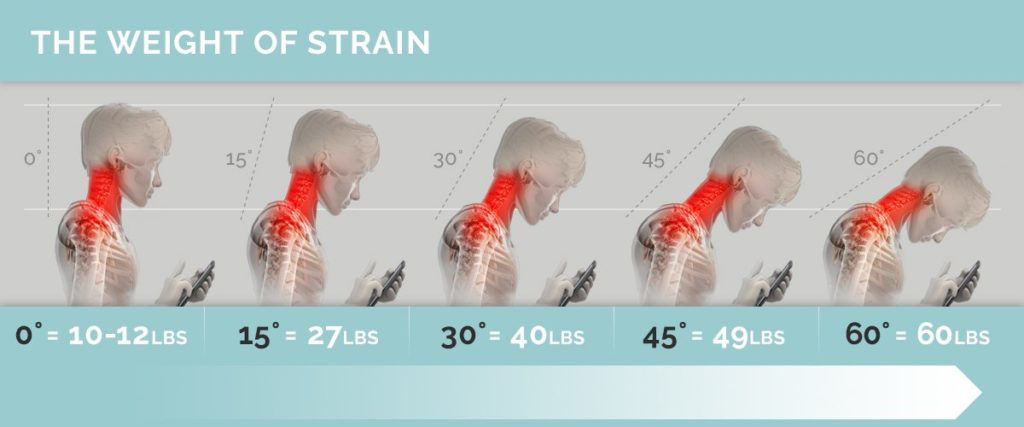
A Modern Epidemic of Poor Posture, Neck Pain, Shoulder Pain, Arm/Hand Neurological Symptoms and Accelerated Spinal Degenerative Arthritis
[“Text Neck” and “Tech Neck” are synonymous]
On Monday, March 3, 2018, the front page of the newspaper USA Today printed a “snapshot” noting that “US consumers spend an average of 7.8 hours each day engaging with digital content.”
Representative Background Story #1
On April 14, 2017, reporter Carolyn Crist wrote an article, published in Reuters Health, titled (1):
Leaning Forward During Phone Use May Cause ‘Text Neck’
In this article, Ms. Crist makes the following points:
- Spine surgeons are noticing an increase in patients with neck and upper back pain, likely related to poor posture during prolonged smartphone use.
- Young patients who should not have back and neck issues are reporting disk hernias and spinal alignment problems.
- “In an X-ray, the neck typically curves backward, and what we’re seeing is that the curve is being reversed as people look down at their phones for hours each day,” said Dr. Todd Lanman, a spinal neurosurgeon at Cedars-Sinai Medical Center in Los Angeles.
- “By the time patients get to me, they’re already in bad pain and have disc issues,” he told Reuters Health. “The real concern is that we don’t know what this means down the road for kids today who use phones all day.”
- People often look down when using their smartphones, particularly when texting as compared to browsing online or watching videos.
- Studies have found that people hold their necks at around 45 degrees forward when using their smartphones.
- When in a neutral position looking forward, the head weighs about 10 to 12 pounds. At a 15-degree forward flexion position, it functions as if it weighed 27 pounds.
- At 60 degrees of forward flexion, the stress on the spine increases to about 60 pounds.
- These prolonged abnormal stresses on a growing spinal column may lead to abnormal spinal development with dire long-term spinal health consequences in adulthood.
- Simple lifestyle changes are suggested to relieve the stress from the “text neck” posture, including holding cell phones in front of the face while texting, and using two hands and two thumbs to create a more symmetrical and comfortable position for the spine.
- Also, people who work at computers or on tablets should use an elevated monitor stand so it sits at a natural horizontal eye level.
- Take frequent rest breaks and/or engage in some physical exercise that can strengthen the neck and shoulder muscles. 1) Lie on a bed and hang one’s head backward over the edge, extending the neck to restore the normal arc in the neck. 2) While sitting/standing, attempt to align the neck with the ears over the shoulders and the shoulders over the hips.
Representative Background Story #2
This week (March 5, 2018), reporter Kirsten Fleming wrote an article that was published in The New York Post, titled (2):
Tech is Turning Millennials Into a Generation of Hunchbacks
In this article, Ms. Fleming profiles the situation of a young man, CY, who began suffering from upper-back pain and neck soreness while in his late teens, subsequent to a habit of hunching over his cellular phone. As his symptoms progressed he developed constant pain, he hunched his shoulders, and the pain caused him to wake up numerous times throughout every night, causing constant fatigue. His upper back and neck would become incredibly tight; his neck was always bent forward.
After a decade of suffering, CY’s chiropractor diagnosed him with “tech neck,” explaining that the cause was the forward/bent neck posture he assumed while using his laptop and iPhone. “Tech neck” is a painful forward head syndrome. It is an increasingly common condition caused by slumping over devices for hours a day, leading to a reversal of the natural neck spinal curve and triggering a physiological imbalance in the upper body.
“Previously seen in middle-age or older desk jockeys and dentists who hunch over patients, it’s now materializing in younger generations who grew up with smartphones, tablets and other personal devices.” Not only does the syndrome cause structural problems in the neck and back, it can also spark breathing and panic issues.
The loss or reversal of the normal cervical curve is easily diagnosed with postural x-rays.
“As posture worsens, the upper back muscles stretch out, while the muscles in the front of the body become weaker and the neck creeps forward.” Young women are particularly susceptible to the condition because they have lower muscle density in their upper body.
“iPhone-obsessed millennials poring over Instagram and Snapchat all day don’t want to admit that their precious electronic lifelines might be detrimental to their health.”
“Undoing the damage is a process that includes breaking bad habits, taking standing breaks and doing exercises such as yoga, foam rolling and stretches that promote good carriage and strengthen core and upper body muscles. Experts also advise patients to hold mobile devices with their elbows at 180 degrees so the screen is in front of their faces.”
Treatment options outlined by Ms. Fleming include chiropractic, restorative postural traction, postural and core exercises.
Consulting chiropractors made the following comments pertaining to tech neck:
- “We’re seeing it in younger and younger children because they’re getting their phones at a younger age.”
- “Now, 20-year-olds have the spine health of a 30- or 40-year-old. It’s an epidemic.”
Dr. Suzie Shay and Dr. David Arthur have seen an increase in the number of patients complaining of neck pain with the use of smart phones. Come in for their comprehensive text neck treatment protocol and rid yourself of “Text Neck”.





